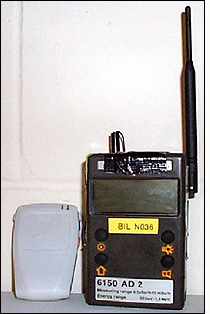Ubisense, a supplier of ultra-wideband (UWB) real-time location systems (RTLS) in Cambridge, England, has partnered with BIL Solutions to provide location information and radiation detection for nuclear power plant workers.
Based in Warrington, England, BIL Solutions offers monitoring, measurement and detection technology and services to the defense, nuclear power and other industries. The company is using Ubisense’s tags in conjunction with Automess radiation dosimeters to provide real-time location information regarding employees involved in decommissioning and clean-up efforts at the Sellafield nuclear power facility, one of 20 aging U.K. nuclear facilities being decommissioned. Located in Cumbria, on the northwest coast of England, Sellafield is home to one of the world’s oldest commercial nuclear power plants. Cleanup of contaminated materials is also underway at Sellafield, due to a nuclear waste leak discovered in 2005.

Employees carrying out work assignments at the power plant wear both Ubisense active tags (Ubitags) and Automess 6150 AD dosimeters, which measure radiation exposure. The radiation measurements, combined with the real-time location information, enable managers to track workers and assess their safety based on radiation exposure. Managers overseeing nuclear clean-up and decommissioning work can use the location and radiation detection information to plan work assignments, says Ubisense CEO Richard Green. If the data shows high levels of radiation in one particular area, Green notes, workers can be instructed to move to another area with lower radiation levels.
Ubisense’s software provides three-dimensional views of the facility, with radiation levels depicted in different colors. Ubisense’s standard platform application programming interfaces (APIs), designed to allow integration of third-party data, combine location data from the tags with the radiation readings. Workers’ dose histories are created and archived to maintain a record of radiation exposure.
BIL Solutions and Ubisense began working together a little more than a year ago, taking the Sellafield project live in December 2006. This is the first time Ubisense’s products have been used in a nuclear power plant, and BIL Solutions hopes to use it at other nuclear sites as well, according to Karl Hughes, a technical specialist with the company.
BIL Solutions chose Ubisense’s technology, Hughes explains, because there were no competing products offering comparable features. He says his company wanted a location system with “real-time capability that did not require perfect line of sight, but that could offer a 3-D spatial accuracy approaching 15 cm in each dimension.”Ubitags operate at 5.8 to 7.2 GHz and transmit a unique 32-bit ID number to RFID interrogators—boxes approximately 6 inches tall and networked through Ethernet cabling. The Ubitags are read 10 times per second, Hughes says, though only one or two are in use at any given time. The Ubisense system employs a minimum of four interrogators are to create cells throughout a building, or across a campus.
At Sellafield, cells can be as large as 15 meters by 15 meters in size. So far, two cells have been configured. The Automess 6150 AD records and transmits the dose rate approximately once per second. “The Automess itself does not transmit data,” Hughes says. “We use a radio modem to do that. It transmits at a standard radio-modem frequency.”
The interrogators read the tags from as far as 150 feet away, then forward the data to the Ubisense Smart Space software platform, integrated into an organization’s existing information system. Unlike conventional RFID systems, which operate on single bands of the radio spectrum, UWB sends a signal over multiple frequency bands simultaneously, from 3.1 GHz to 10.6 GHz. UWB signals are also transmitted for a much shorter duration than those used in conventional RFID. Last month, the European Union spelled out conditions for using ultra-wideband technology across the European Union (see EC Spectrum Decision Expected to Boost UWB RFID Adoption).
With an estimated price tag of $126.5 billion, the ongoing nuclear power plant decommissioning efforts in the United Kingdom are a costly undertaking. Green says this ability to monitor the radiation exposure and manage workers in real time can improve productivity.
Vishnu Sivadevan, a research analyst with consulting and market research firm Frost & Sullivan, agrees that Ubisense’s RTLS products can boost productivity and also improve worker safety. Research has proven UWB technology to be well suited for harsh indoor environments, he says, making UWB-based products “highly suited for locating and tracking people in nuclear facilities.” Sivadevan believes Ubisense RTLS products have demonstrated a high degree of location accuracy, which he says is imperative in a setting such as a nuclear power plant. “The safety of the employees working in such environments is improved considerably.”
According to Green, Ubisense recently landed two other nuclear power customers, one in Canada and another in France, that also plan to incorporate the RTLS technology into their radiation-detection systems. Overall, business is picking up for the five-year-old company—last year, he says,, it doubled the number of its customers to about 165. Those customers include the U.S. Army, which is using Ubisense technology to track soldiers on training missions at Fort Benning (see U.S. Army Uses UWB to Track Trainees), and Fish Software, a maker of interactive tools for trade shows and consumer events, which is using the company’s RTLS to help identify and monitor trade-show attendees (see UWB to Help Sales Staff Fish for Leads).

